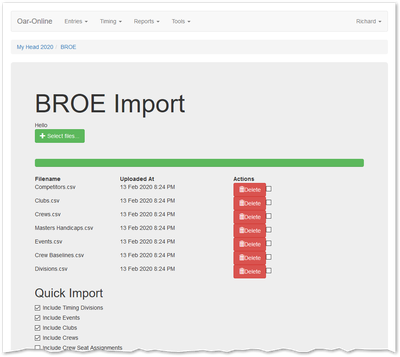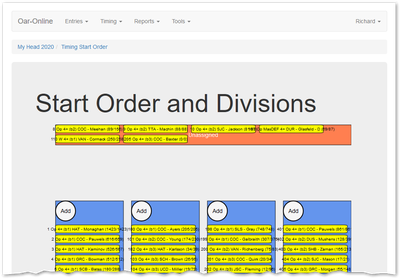Head Workflow
Head Race Workflow
Meeting Creation - initial meeting creation is done by a system administrator. This involves creating the empty competition and assigning permissions to the competition administrator. At the end of this step the competition admin will be able to import crews, prepare a draw and take the competition to fruition.
-
Meeting Settings - whilst Oar-Online defaults to a perfectly usable setup it is advisable to consider what is appropriate for your competition and to adjust accordingly. Specifically consider:
the draw method/policy for the race;
whether crews should be named after the crew stroke rower or using the BROE crew names; and
the number of crews needed to enter/race to be eligible for a prize.
-
Pre-BROE Import - before importing the competition data from BROE we generally advise that the entries team perform the usual audit tasks on entries received. Specifically:
ensure that all crews have appropriate competition;
any crews that do not have competition should be marked as rejected or withdrawn, any scratched crews will be included in the draw import and this is often not wanted during initial draw setup;
perform any event banding; and
move any masters handicap groupings into a single event.

BROE Import.
-
BROE Import - import of club, event, crew, competitor data from BROE is a simple task.
then upload the zip into Oar-Online to make it available for the data import.
use the quick import to pull in: timing divisions; clubs; events; crews; crew doubling; boat doubling; crew timing division assignments; and auto-sort events.
Once imported review the overall import on the Entries Dashboard to ensure that the number of events, clubs, crews, divisions, etc, have been imported.
The imports can be repeated multiple times but refer to detailed documentation for details of procedures and pitfalls to be aware of.
-
Data Review/Tidy Up - once imported the BROE data will likely need some tidy up. Most of this involves relatively minor naming or formatting issues but some does involve review of data that is not 100% provided by BROE. Check:
that Masters' age categories have been correctly assigned. BROE only reports current crew roster age so the imported age may not reflect the actual intended handicap age or even reflect the age when crews were baselined at close of entries.
that the division order is appropriate for draw/crew numbering purposes.
that the event order is appropriate for draw purposes. In the default case the event order is used to automatically arrange the draw/start-order. Getting this correct is important for streamlining draw production.
Other, mostly cosmetic, but advised cleanup is as follows:
review club names - The names provided by BROE tend to be very long and often have artifacts that are not desirable in a draw, e.g. "(Durham)". "Sunderland, City of, Rowing Club". Oar-Online allows three variations on the club name: a full name, a normal name and a shorter abbreviated name. It will try to use the longest name that will fit in a report field.
review event names - The space available for displaying event names is fairly limited and sometimes the short event name needs tweaking to make it fit in some report fields.
additional event details - Typically only needed for some Regatta competitions but Trophies, Previous Winners, Sponsors and long event names can be setup for inclusion in the formatted programme/draw/results.
crew names - check capitalisation of crew names when using stroke names or check the appropriateness of BROE crew names where clubs have customised a name.

Head Race Draw.
-
Head Draw - in general we prefer to make the actual start-order draw an automated process. This simplifies the workflow and also can be argued to remove human bias from the overall process. However there are many cases where manual tweaks are required. Our recommended workflow is as follows:
decide on a draw method in the initial meeting setup. In general we tend to favour/recommend the use of Event order, then PRI for the draw. This places the highest pointed crews first in the start order and it is a demonstrably measurable criteria plus should have a very definite correlation to the expected speed of each crew. It might not be appropriate in all situations, especially those with very tight bands but it does work well in general.
arrange events into general speed order in BROE post-import.
automatically draw each division using the event order and within each event draw according to the draw method. Note that all crews within an single event are kept together to minimise changes in conditions for different crews within that event.
manually drag-and-drop crews around in the start order to tweak things based on Organising Committee knowledge and competitors requests. But note that any manual changes should be done in line with Competition policy and regards for fair and equal racing. If in doubt consult with your Race Committee Chair who is the Competition's authority on the application of the Rules of Racing.
-
Boating Locations/Boating Times - both of these are optional items but can be useful tools for tracking crews and managing the boating process.
boating locations are setup in the meeting setup screen. Each location is assigned a short code, suggest 3 to 5 characters to fit in reports, and a longer name.
assign locations to each crew in the start-order
-
assign boating times to each crew. We tend to advocate a system of working out the average boating speed for each boating location based on boat type and then working backwards from last boating time.
For instance we may say that in a five minute period at a set of steps: 2 eights, or 4 fours, or 6 doubles/pairs/singles can boat. Then work backwards allocating the right number of crews based on the start of each time period.
Time-only and scratched crews - crews can be marked as scratched or timing start order entries can be marked as time-only. These will appear on the printed draw as appopriate.
Assign crew and event numbers - once the start-order is ready then assign crew numbers and also event numbers. Crew numbers can be assigned for the competition overall; or can be assigned on a per-division basis.
-
Reports/Draw export - a number of stakeholders depend on the draw:
crew numbers to printers - if custom printed numbers are required produce the Crew Numbers by Club export and send to a provider such as Stacy who will include crew details of the respective race number.
draw for competitors/officials - in either PDF or XLS formats and with or without boating locations/times.
BROE2 Custom Crew info - to inform BROE about the allocated crew race numbers and the names used in the draw. This allows searching within BROE using either of those fields.
Club Summary reports - for generating race number packs
Cox lists - for weighing in purposes listing minimum weights and cox name/membership number - import crew seat assignments for this report to contain cox details.
Crew membership lists - for control commission checking
Many of the reports above can be produced on a per-boating location or per-club specific basis too.